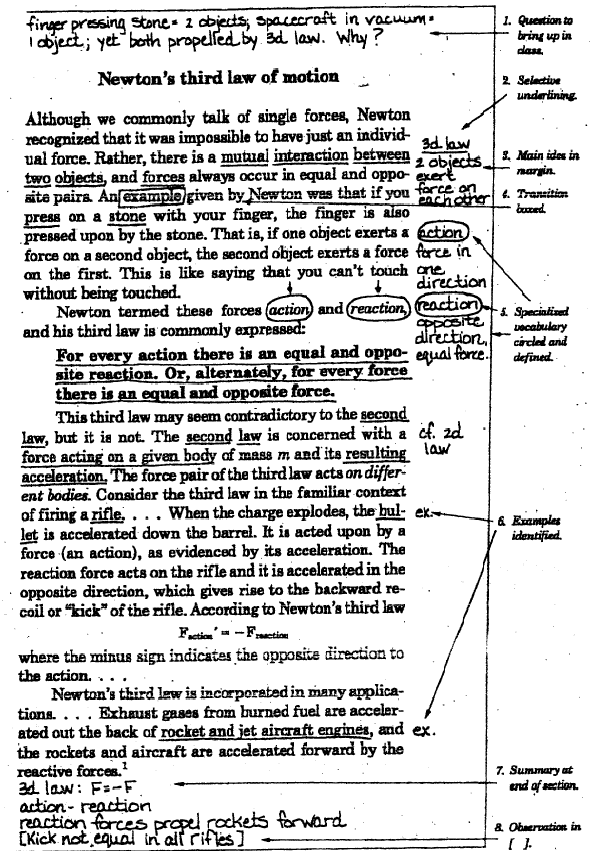Maximize Comprehension
Maximize Comprehension by Marking Your Texts
These ten suggestions will help you mark your textbooks so they will be of immediate and lasting value to you. An illustration of a section of a textbook that has been marked according to these recommendations follows.
-
Read first and then underline selectively. Make conscious decisions about what to underline and limit the amount. Too much underlining is difficult to study later and often becomes a mechanical process that requires little thought. Read a section of material first and then go back and underline only the words and phrases that most accurately state what that chunk of material is mainly about.
-
Box transitions and number important ideas. Making transitions stand out in the text helps you locate the ideas. When you box such words as first, for example, next or finally, you not only locate important ideas more easily, you also see how they relate to each other.
-
Circle specialized vocabulary. Write brief meanings in the margin if you need to. You need to know these terms to understand the textbook and the instructor, and take the exams.
-
Jot down main ideas in the margin. At the end of a paragraph, stop and ask yourself, "What was most of that paragraph about?" Write the answer in as few words as possible in the margin. This is an especially useful technique for short dense assignments that are difficult to understand, such as those in philosophy, physics, or chemistry.
-
Label Examples (ex). When you encounter an example, determine what main idea it exemplifies and label it. It will help you understand the main idea when you study later.
-
Write your own ideas, including connections with your other classes, in [square brackets]. If you are reading actively, concentrating and understanding, you will also be thinking. Jot down the ideas that occur to you either at the top or the bottom of the page and bracket them to indicate they are your own. Your recorded ideas will make later study more interesting and will also provide ideas for class discussions, papers, and exams.
-
Write questions as you read. Questions help you think, relate new material to what you already know, and wonder about implications and applications. All these mental activities help you learn the material in the first place and remember and use it later.
-
Write brief summaries at the end of each section of material, and later; at the end of chapters and the book. Use the white space throughout the book to write summaries. Write them in brief phrases only. They should answer the questions "What was this about? " and "What did the author say about it?" Summarize your own words as much as possible. Don't read and write at the same time, or you will end up with too many notes.
-
Make outlines of obvious major ideas in the margins. Outlines are a visual representation of ideas and their relation to each other. At times, obvious transitions will make the ideas stand out. When you encounter such material, write brief outlines of the ideas in the margins.
-
Make maps. Outlines force you to isolate and organize important ideas so you can visualize them and thereby understand and remember them. Writing ideas in map form accomplishes the same thing. You can map major sections, chapters, or even entire books. Experiment with summaries, outlines, and maps and decide which work best for you.

